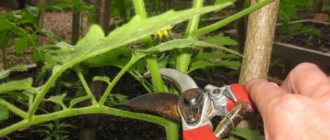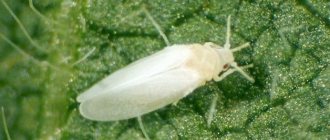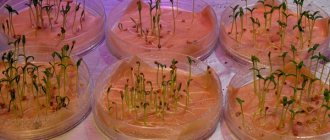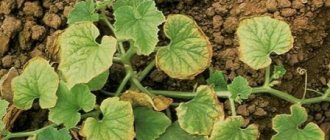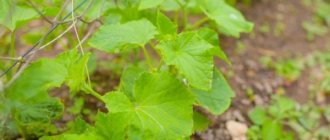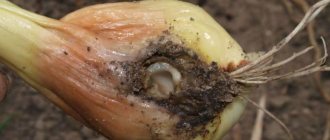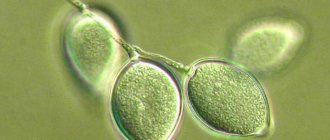Causes
Blackening of tomatoes is a common symptom of many diseases. Brownish, dark gray or brown spots appear suddenly. After a few days they turn into black lesions. Bushes die and crops are lost.
- late blight;
- stem necrosis;
- excessive dryness of the soil;
- crown rot;
- gray rot.
With blossom end rot, hardened pulp can be found under the darkened skin. The tomatoes are completely dry due to lack of juice.
What reasons lead to blackness due to blossom end rot:
- saline soils with excess minerals;
- overdose of fertilizers;
- insufficient watering in the midst of heat and dry weather;
- deficiency of calcium and potassium salts during fruiting.
When affected by the fungus, late blight initially darkens and the leaves become damaged. You can find typical brown spots that increase in size over time. The disease occurs at high humidity due to frequent precipitation.
Reasons for the appearance of blackness on tomatoes
Dark and later black spots can appear on completely different parts of the plant, so why does this happen?
- If the leaves turn black at the seedling stage, it means that the soil is not suitable for the plants or the rules of care have been violated.
- A black trunk indicates a “black leg” disease.
- The dark lower leaves of an adult tomato appear from late blight.
- Alternaria causes blackening and curling of the ends of leaves.
- Even green tomato fruits turn black due to the following diseases: Alternaria blight, bacterial canker, blossom end, gray or watery rot.
Greenhouse and hothouse tomatoes may have leaves that turn black and dry out due to increased humidity inside the structure. The fungus grows more actively in very humid environments.
What to spray with?
In the initial stages, the bushes are immediately irrigated with copper preparations.
You can spray with 1% Bordeaux mixture and copper sulfate. 1% Fitosporin gives a quick effect. Good preparations for treating bushes:
- Ridomil Gold,
- Fitosporin,
- Quadris,
- Tattoo,
- Acrobat.
If the fruits have already begun to turn black, they are torn off and burned. At the same time, all weeds are weeded and removed.
For blossom end rot, if the cause is calcium or potassium deficiency, add
- potassium products without chlorine at the rate of 1 tbsp. for 10 l
- or calcium nitrate in the amount of 2 tbsp. for 10 l.
Folk remedies for spraying against blackening with late blight:
- Blue stone with lime. Use in a ratio of 1 to 1, diluted in water.
- Soap-copper solution. Prepared from 20 g of copper sulfate, 200 g of grated or liquid soap. Add to 10 liters of water.
- Garlic solution. 100 g of cloves per 1 glass of water. Insist for 1 day. Pour into 10 liters of water. To enhance the effect, add 1 g of manganese.
- Kefir solution. 1 liter of dairy product is diluted in 9 liters. Insist for 1 day.
To strengthen the bushes, growth regulators are used. They increase the resistance of tomatoes to pathogens. Thanks to them, immunity to dangerous fungi and bacteria increases. What can be used and sprayed with:
| Activators | Features of breeding in water |
| Oxyhumate | 10 ml per 1 l |
| Ecosil VE | 1 ml per 3l |
| Ecosil | 1 ml per 3 l |
| Epin | 2 ml per 10 l |
| Epin plus | 2 ml per 10 l |
Green tomatoes without massive spots are picked and watered with water heated to 70-75 degrees. Place in boxes in the light for ripening.
Blackened leaves, trunks, and fruits are burned in the fire. They are not used for composting.
Preventive methods
Preventive measures give remarkable results and reliably protect against infection. The soil can be watered with Fitosporin or Bordeaux mixture in advance in the spring. In autumn, copper sulfate is used for treatment.
To correct soil acidity, add:
- lime;
- soda ash;
- baking soda.
What are the methods of prevention:
- 10-14 days before planting seedlings, young bushes are sprayed with 1% Bordeaux mixture.
- 2 weeks after planting on the beds, for the purpose of prevention, they are sprayed with Penncozeb, Metaxyl SP. These are fungicides with contact-systemic action. Metaxyl is diluted at the rate of 80 g per 10 liters of water. Acrobat is prepared in a proportion of 40 g per 10 l.
- Then preventive irrigation with fungicides is carried out 1-2 times a month. The solution consumption is 0.5 l per 1 m2.
What drugs are recommended for prevention:
| Name | Quantity per 10 liters of water |
| Tridex VDG | 16 g |
| Azophos | 100-150 ml |
| Medex | 100 ml |
| Ditan M-45 | 12-16 g |
| Pennkozeb | 16 g |
The last irrigation is carried out 20-25 days before harvesting.
Among the folk remedies used to prevent fungal infections and prevent blackening are:
- pouring with sour milk, whey, kefir;
- fertilizing with a solution of live yeast;
- piercing tomato trunks with copper wire.
source
Blackening and rotting of tomatoes is a common problem. It can arise due to many mistakes that almost every gardener makes. Not every blackening is a sign of a disease; it is important to learn to identify the true cause of the disease and learn to cope with it even before it occurs, using preventive control measures.
Bacterial cancer
As the name implies, the disease is caused not by fungi, but by harmful bacteria. They get into seedlings from poor-quality soil. Therefore, as a preventive measure, purchased soil must be disinfected before planting seeds.
The disease appears as spots on all parts of the plant. At the first sign of it, the bush is treated with Tomato Rescuer, Fitosporin or Fitoflavin.
Note!
White bulk tomato - differences from other varieties, growing region, advantages and disadvantages, features of planting tomatoes
Black midges on tomatoes - which plants repel them, how to get rid of insects, how to treat or spray the stems against small flies
Why tomatoes wither - in open ground, growing in greenhouses, signs of nutritional deficiency, what to do if they dry out, prevention
Why do tomatoes rot on the bush?
There are a lot of reasons. These are unfavorable weather conditions, improper care, and an unsuitable variety of tomatoes for the site. But the most common reasons, as many years of practice have shown, are those described below.
Gray rot
A fungal disease that can destroy almost the entire crop. The danger is that the disease actively begins to develop precisely during the ripening period of tomatoes. High humidity and unbalanced feeding with vitamins can be considered activators.
Signs of gray rot development:
- The appearance of gray or brown spots on the fruits;
- darkening on the nodes and stems, which seems to stretch across the surface of the seedling;
- death of plant tissue;
- the appearance of cannon plaque;
- formation of spots on the outer surface of the sheet.
Gray rot instantly affects neighboring seedlings, moving from bush to bush. Tomatoes begin to die, wither and fall off. Dig up and burn all diseased seedlings. It is advisable to dig up the soil and disinfect it. The ideal option is to introduce a new soil layer. If gray mold is found in a greenhouse, the cause is most likely due to high humidity. Therefore, when growing new seedlings, ventilate the room daily, install vent windows so that fresh air circulates around the clock.
Never use affected bushes as humus. The fungus is difficult to treat and can easily spread to a new crop.
Late blight
Also applies to fungal diseases.
It spreads quite quickly, but unlike gray rot, in the initial stages of development it is almost impossible to establish the fact of damage. Favorable conditions for development are windy weather and high humidity.
- white fluffy coating on the inner surface of the leaf;
- tissue necrosis;
- dark spots on the surface of the fruit;
- As the disease affects the tomatoes, they take on an ugly shape, the usual circle is distorted, and the fruit dries out;
- softening tomatoes;
- the appearance of a putrid odor.
It is useless to treat seedlings for late blight. The fungus spreads so quickly through the veins that only preventive measures can be used - that is, treat the beds with chemicals in advance. When the seedlings are already affected, pull them out and burn them. They are not suitable as humus, as they will infect new shoots. If you want to prevent the development of late blight, then do not plant tomatoes close to potatoes, be sure to install supports for staking the bushes and inspect the beds as often as possible to identify the subject of infection.
Dry soil
This circumstance during the period of fruit formation leads to the formation of blossom end rot, but, as a rule, only if the nitrogen content in the soil is exceeded. The seedlings simply do not have enough strength to fight the fungus. Dry soil leads to the death of ovaries and drying out of flowers.
Apical rot
It affects young seedlings that are preparing to bear fruit. The disease is not fungal, but bacterial, and therefore does not affect the entire plant at once. Signs of damage:
- flat and depressed watery spots;
- gray-black spots on fruits;
- arrest in development and deformation of tomatoes.
There is no treatment, only prevention, which must begin from the moment the seeds are prepared. After detecting a source of disease, all seedlings must be destroyed and the soil treated.
Under no circumstances should you eat infected fruits. This may have a negative impact on your health.
Brown or dry spotting
Fungal diseases that begin to affect the lower leaves of seedlings.
As the disease progresses, the spots become larger and gray-brown in color, covering more leaves. Gradually, the leaves and stem begin to dry out and die. The fruits become covered with dark depressed spots, and with high humidity, fungal spores at the site of the lesion begin to multiply by spores, forming a white-fluffy coating.
You can fight the fungus by treating it with chemicals, and if the fruits have already begun to form, then biological products will help you cope. In case of severe damage, remove the seedlings and do not eat the affected fruits.
Stem necrosis
Necrosis affects already formed seedlings at the moment when tomatoes begin to form. Signs of necrosis:
- the stem cracks at the bottom;
- dark green, black cracks;
- leaves wither;
- tomatoes do not ripen and fall off.
The virus cannot be treated. The bushes must be removed from the garden bed and the soil must be cultivated.
Lack of care
Lack of care, expressed in lack of tying, improper application of fertilizers or improper watering, can lead to rotting of seedlings.
All varieties of tomatoes, even low-growing ones, need staking. Since tomatoes lying on the ground or tightly adjacent to each other increase the chances of fungal infections and crop loss. Excessive amounts of nitrogen with untimely watering will lead not only to a stop in development, but also to the formation of blossom end rot. And when irrigated by sprinkling on a hot sunny day, it can also lead to the formation of fungal diseases or tissue necrosis.
It is best to water tomatoes at the root. The ideal time is early morning, evening or cloudy day.
Stem necrosis
Now we need to consider the most serious disease, in which the stems of tomatoes turn black. Black necrosis is a viral disease that begins to manifest itself only when the first bunches of fruit appear on the bush. First, cracks appear on the lower part of the stem; they are still dark green in color, but will soon begin to turn black. From the cracks, the rudiments of aerial roots will appear, but this is a deception, the disease is progressing. Very soon the plant falls and dies. It is very difficult to treat a viral disease; at the first symptoms, the bush must be pulled out and burned. It is recommended to treat the soil with Fitolavina solution.
Why do green tomatoes turn black?
There can be many reasons.
The most common are: fungal diseases, black rot, late blight. Improper care also causes darkening. It is strictly forbidden to eat affected fruits, even if the stain is very small. Blackness can also appear from growing in excessively dry soils or soils with a high nitrogen content, or if some of the roots are exposed to the surface.
The occurrence of darkening is due to a lack of magnesium or boron, which must be replenished simply by feeding the seedlings with microelements from any manufacturer, but with a high content of the missing elements.
Why do tomatoes turn black in a greenhouse?
Unlike open ground, there are much fewer reasons for darkening the surface of fruits in a greenhouse. As a rule, blackness appears when the temperature regime is violated, high humidity and lack of ventilation. To solve the problem, ventilate the greenhouse premises daily or install several vents for constant circulation of fresh air. Install a thermometer for more accurate temperature control.
Signs of blackening of tomatoes
The appearance of small black spots that are hard to the touch and without an unpleasant odor does not indicate any manifestations of the disease.
Such “moles” appear from excessive solar activity and tomatoes can be eaten without fear. But if the blackening is soft to the touch, affects most of the tomato, has a fluffy coating and emits an unpleasant odor, then this is a direct indication of the development of a fungal or viral disease. It also attacks the stems and leaves of seedlings.
Tomatoes are turning black, what should I do?
Pay attention to where the bed is located. The place should be well ventilated and lit during the day. If you are growing tomatoes in a greenhouse, make sure it gets fresh air every day.
In dry weather, 2 times a week is enough. Water strictly at the root; the sprinkling method is not suitable for tomatoes.
Choose varieties with an average ripening period, these produce fruits before they have time to become infected with late blight.
Pinch and pinch out excess aerial roots, tear off excessively large leaves, as well as leaves with slight lesions or darkening.
Anthractosis
The disease begins at the root of the plant. Then it spreads to the fruits. Dark dents appear on them, the tomatoes rot from the inside. Having detected signs of disease, the bush is treated first with colloidal sulfur, and then with a fungicide.
How to save the harvest?
The harvest can be saved at the seed preparation stage.
Soak them in a disinfectant solution for 20-30 minutes. Before placing in the ground, treat the soil and under no circumstances plant in a place where there was late blight or other types of fungal diseases last year. During the growth process, carefully monitor the seedlings and apply mineral fertilizers correctly. As a rule, a lack of magnesium, boron and nitrogen is detected.
Be careful with nitrogen, as if not watered on time, it will cause blackening several times stronger. Treatment will not help if the seedlings have been infected, focus on prevention.
How to treat tomatoes to prevent them from turning black?
Before fruit formation, treat with chemicals and fungicides, and during ripening with biological preparations. They are safe for both crops and humans. For example, you can use drugs such as mentronidazole, phytosporin, Agat-25. They should be treated every 2 weeks. The use of traditional methods (for example, spraying with a solution of iodine and milk, treatment by spraying dry ash 7 days after planting seedlings) is permissible at the ripening stage of tomatoes, since the substances included in the mixtures are safe for humans. Don’t forget to inspect the bushes weekly and tear off affected, dry leaves.
How to treat tomatoes to prevent them from turning black after harvest?
After collecting the fruits, they can be processed in hot water, or rather, heated for several minutes. The water temperature should not exceed 60 degrees. Pour water into a bowl of water and place the fruits there. Let dry naturally and store.
Choose unripe fruits. Do not let the tomato skins curl. Otherwise, their shelf life will be reduced to several hours.
How to protect tomatoes?
After detecting small black spots, you must immediately begin fighting the infection.
- First, spray the plants with a calcium chloride solution or salted water . It's best to do this on a cloudy day.
- Bordeaux mixture is also effective in the fight against fungus, which destroys its spores.
In order to save the tomato crop from death, it is necessary to apply the following methods:
- choice for planting light areas;
- carrying out pinching and pinching tomatoes;
- proper watering of beds;
- removing excess leaves.
From illnesses.
- For anthracnose and other diseases, it is effective to spray the bushes with a preparation such as Profit Gold.
- of copper sulfate is also suitable for this purpose .
- It is also important, if signs of a fungal infection are detected, to remove all damaged tomatoes and leaves, and carefully dig up the soil in the garden bed.
Seeds purchased by hand sometimes become a source of infection for tomatoes. Before sowing, they must be treated with a weak solution of potassium permanganate, which has a disinfecting effect.
How to prevent the spread of the disease?
Despite the fact that fungal and viral diseases spread quickly and it is not recommended to eat fruits after infection, with the help of preventive measures it is possible to prevent the development of diseases.
Prevention
Fighting with folk remedies
Take 300 grams of garlic or onion, pour 5-10 liters of water and place the ingredients there. Insist for 24 hours. Then strain and use a garden sprayer to spray the tomato beds.
Based on lactic acid bacteria. They prevent fungus from developing and prevent the development of diseases. Take 100 grams of fermented milk product and dilute it in 1 liter of water. Treat the beds with the resulting solution using a spray bottle.
Mix one glass of salt in 5 liters of water until the solution is homogeneous and spray the bushes until the fruits ripen.
Watering
Water the beds early in the morning or in the evening when the sun is not as active. It is strictly prohibited to use the sprinkling method, especially after treatment with chemicals or biological preparations. Water should flow strictly to the root.
Stepsoning
Be sure to pick off all the shoots and lower leaves of the tomatoes. Form low bushes into three stems, medium height bushes into two stems, and tall varieties into one stem. This will not only protect against the development of fungus, but also accelerate the growth of fruits.
Crop rotation
If you have anything from the nightshade family (tomatoes, potatoes, eggplants) growing in your garden bed, then you can plant the seedlings again in the same place after 3-4 years. Otherwise, the harvest will suffer the same problems as last year.
Do not plant tomatoes next to potatoes or eggplants, as they carry the same diseases. Ideal predecessors would be cucumbers, onions, garlic, cabbage, and corn.
Landing place
It should be located in a draft, the soil should be dry, loamy, low in nitrogen, slightly acidic and well heated.
Brown spot
This disease appears only on the leaves. Dark brown dots appear on them. If the disease is not treated, holes form in place, the leaves become deformed, dry out, and behind them the entire bush dries up.
The good news is that spotting is easy to treat. To do this, it is enough to treat the plant with any preparation containing copper.
Tips, secrets
- An extraordinary, but working tip is to pierce the base of the seedling's trunk with copper wire, 3-4 cm from the bottom of the trunk.
- Don't plant bushes too close. The ideal distance between them is at least 30 cm. So, if the disease strikes one of the seedlings, it will not have time to spread to other plantings.
- Apply mineral and complex fertilizers in a timely manner. This will help boost your immunity and fight the fungus.
- If you notice darkening of the leaves, but the fruits look healthy, you most likely overdid it with nitrogen. To stabilize its level in the soil, add sand, peat, and also thoroughly water the bed with tomatoes.
- Before germinating the seeds, warm them in the oven for a few minutes. Be careful not to burn the seed.
- After each watering, dig up the soil and inspect the leaves, especially their lower parts.
Dry soil
If you haven’t hilled up your plantings for a long time, and also water them at large intervals (the cottage is located far away), then don’t be surprised that the roots protrude outward and the tomatoes turn black. We will now discuss what to do. The same symptoms can occur with a lack of nutrients. In this case, it is necessary to adjust the watering regime, fertilize the plantings using vermicompost or mullein, and also hill up and mulch the bed. Your plants will begin to grow again, and the signs of the disease will slowly disappear. Please note that a lack of microelements may be associated with tomatoes growing in one place for a long time. Crop rotation is essential for the health of your plants.
Reviews
I built the greenhouse, as it seemed to me, according to all the rules. Prepared the seedlings for transplanting into the ground and watered them in a timely manner. But then I discovered that almost all the seedlings were affected by a disease, some kind of fungus. The neighbor said it was because there were no windows in the greenhouse. Yes, I myself did not know that it was necessary to ventilate. Next year I will definitely re-equip the greenhouse so that fresh air can flow in.
I read somewhere that tomatoes like dry soil and rarely water them. As a result, almost all of them turned black before they even had time to ripen. I was looking for the reason why this happened. I realized that due to the fact that there was a lot of nitrogen in the soil, they turned black. And if I watered more often, nothing would happen. I have developed an ideal schedule - 2 times a week, if the temperature is above +35 degrees.
source
Prevention
To prevent tomato diseases from appearing, it is important to properly clean the garden area in the fall.
- All tomato shoots must be removed from the ground along with the roots.
- Dried tops need to be burned.
- Treat the soil with copper sulfate, sprinkle with ash, and only then dig up.
- If you were unable to do this in the fall, cultivate the soil in early spring.
When the soil warms up, mustard can be planted at the future planting site. When it grows, dig up the soil along with the sprouts. The plant belongs to the phytoncides and can kill harmful fungi in the soil.
You can and should fight black spots on tomatoes. To do this, you can use traditional methods or more effective chemicals. The main thing is to correctly identify the disease by its characteristic signs.

